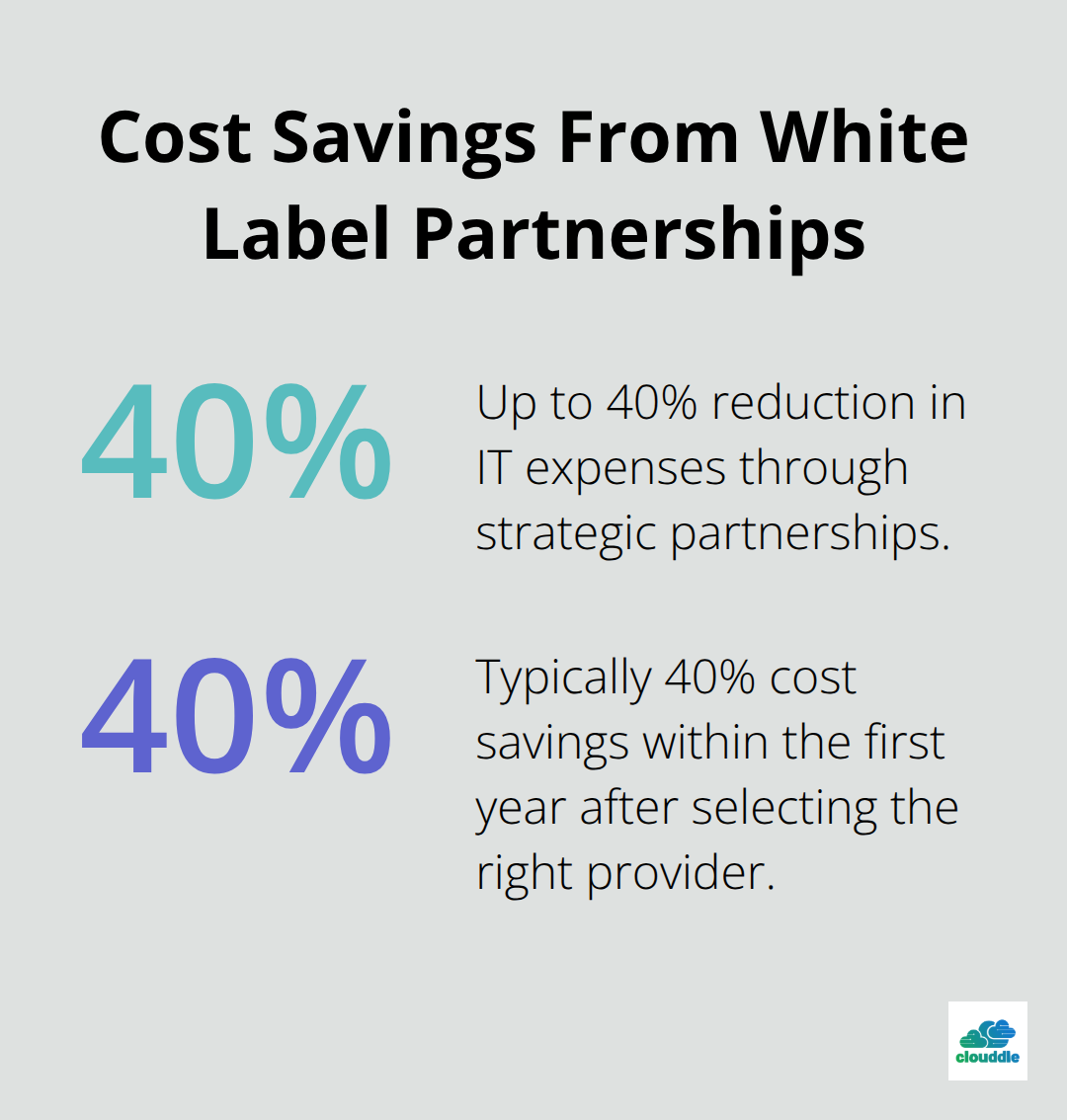Selecting the right white label IT solutions can transform your business operations and reduce overhead costs significantly. Many companies struggle with this decision because they lack clear evaluation criteria.
At Clouddle, we’ve seen businesses save up to 40% on IT expenses while improving service quality through strategic white label partnerships. This guide provides a framework for making informed decisions about your IT infrastructure needs.
What Are White Label IT Solutions
White label IT solutions represent a partnership model where one company provides technical services that another company rebrands and sells as their own. This approach includes managed IT services, cloud infrastructure, cybersecurity monitoring, help desk support, network management, and specialized software platforms. The SaaS market was valued at $266.23 billion in 2024 and is projected to grow to $315.68 billion in 2025, which makes white label partnerships increasingly attractive for businesses that seek rapid expansion.
Core Service Categories
Most white label IT providers offer comprehensive service portfolios that span infrastructure management, security operations, and user support. These services typically include 24/7 monitoring, patch management, backup solutions, and incident response. Unlike traditional IT outsourcing where you simply hire external help, white label solutions allow you to offer these services under your brand to your own customers.
Healthcare organizations particularly benefit from HIPAA-compliant solutions, while financial services leverage specialized compliance frameworks. Manufacturing companies often focus on network reliability and industrial IoT management (which requires specialized expertise), whereas retail businesses prioritize point-of-sale systems and customer data protection.
Strategic Advantages Over In-House Development
White label solutions reduce time to market dramatically compared to internal capability development. Companies can achieve significant cost savings while they access enterprise-grade infrastructure immediately. The model eliminates the need for specialized staff recruitment, extensive training programs, and technology investments that typically require 12-18 months to implement effectively.
This approach allows businesses to focus resources on core competencies while they expand service offerings through proven, market-tested solutions. Companies can redirect saved development costs toward marketing and customer acquisition efforts instead of expensive technical infrastructure (which often requires ongoing maintenance and updates).
Technical Infrastructure Requirements
White label providers maintain robust infrastructure that supports multiple clients simultaneously through multi-tenant architecture. This setup allows businesses to serve various customers with personalized, secure IT solutions while they use a single platform. The infrastructure typically includes redundant systems, automated failover capabilities, and scalable resource allocation that adapts to client demands.

Most providers offer API integration options and webhook support, which enables seamless connection with existing tech stacks and databases. These technical capabilities become essential when you evaluate potential partners for their ability to integrate with your current systems and workflows.
How to Select the Right White Label IT Provider
Technical expertise forms the foundation of any successful white label partnership. Demand specific certifications from potential providers, including SOC 2 compliance, ISO 27001 security standards, and industry-specific credentials like HIPAA for healthcare or PCI DSS for financial services. The provider’s service portfolio should include comprehensive monitoring capabilities with 99.999% uptime guarantees, automated patch management systems, and incident response protocols with defined resolution timeframes.
Request detailed technical documentation about their infrastructure redundancy, disaster recovery procedures, and scalability mechanisms. Strong providers maintain dedicated technical teams with specialized knowledge across multiple domains rather than generalist support staff.

Support Response Standards and Quality Metrics
Service level agreements must specify exact response times for different severity levels. Tier 1 critical issues should receive acknowledgment within 15 minutes and resolution within 4 hours maximum. Many providers promise 24/7 support but deliver inconsistent quality during off-hours or weekends.
Test their actual response capabilities through trial periods or reference calls with existing clients. Evaluate their escalation procedures and access to senior technical resources. The best providers offer multiple communication channels including phone, email, and secure messaging platforms with ticket tracking systems that provide real-time status updates.
Contract Terms and Pricing Transparency
Pricing models vary significantly between providers, with some charging flat monthly fees while others use usage-based structures or tiered access for premium features. Avoid providers with hidden costs for setup, integration, or data migration services (which can add 30-50% to your total expenses).
Contract flexibility becomes important when your business needs change rapidly. Seek agreements with quarterly review options rather than rigid annual commitments. Negotiate clear termination clauses that include data portability guarantees and reasonable notice periods. The most reliable providers offer transparent pricing calculators and detailed cost breakdowns that account for scaling requirements.
Infrastructure Assessment Requirements
Your current IT infrastructure determines which white label solutions will integrate most effectively with existing systems. Document your network architecture, security protocols, and software dependencies before you evaluate potential partners. This assessment reveals compatibility gaps that could create implementation challenges or require additional investment.
How Do You Successfully Deploy White Label IT Solutions
Infrastructure compatibility determines deployment success more than any other factor. Conduct a comprehensive network audit that maps current bandwidth utilization, identifies legacy system dependencies, and documents security protocols before you select your white label partner. Companies with mixed environments that run both cloud and on-premises systems face integration challenges that require specific API capabilities and data synchronization tools.
Document your existing service level agreements, backup procedures, and compliance requirements to match them with provider capabilities. Most integration failures occur because businesses underestimate the complexity of connecting new systems with established workflows.
Staff Training and Change Management Strategies
Technical teams require focused training on new monitoring dashboards, ticketing systems, and escalation procedures within the first 30 days of deployment. Schedule hands-on sessions with your white label provider’s technical specialists rather than rely on generic training materials.
End users need clear communication about service changes, new support channels, and updated contact procedures. Resistance typically decreases when staff understand how new systems improve their daily operations. Create detailed documentation for common procedures and establish internal champions who can support colleagues during the transition period.
Performance Tracking and Success Measurement
Track specific metrics including mean time to resolution, first-call resolution rates, and system uptime percentages from day one. Establish baseline measurements before implementation to demonstrate improvement accurately. Monitor cost per incident, user satisfaction scores, and service availability metrics monthly rather than quarterly.
Most successful deployments show improvements in response times within 90 days. Set clear benchmarks with your provider for critical metrics like network uptime above 99.5% and security incident response under 4 hours (which prevents major business disruptions). Regular performance reviews with your white label partner help identify optimization opportunities and prevent service degradation over time.
Integration Testing and Validation
Test all system connections thoroughly before you go live with production environments. Run parallel operations for at least two weeks to identify potential conflicts between new and existing systems. Validate data synchronization processes and backup procedures during low-traffic periods to minimize business impact.
Create rollback procedures that allow quick return to previous configurations if problems arise. Document all integration points and maintain updated network diagrams that reflect new system connections (which become essential for future troubleshooting).
Final Thoughts
White label IT solutions demand thorough evaluation of technical expertise, support quality, and transparent pricing structures. The most successful partnerships combine proven infrastructure capabilities with responsive customer service and flexible contract terms that adapt to business growth. Companies that select the right provider typically achieve 40% cost reductions within the first year while they gain access to enterprise-grade security and monitoring capabilities.

These partnerships eliminate the need for extensive internal IT teams and accelerate service delivery to customers. Business decision makers should document current infrastructure requirements and compliance needs before they begin their search. Test actual response times through trial periods and focus on partners with multi-tenant architecture and API integration capabilities that support seamless system connections.
We at Clouddle provide managed IT, networking, and security services specifically designed for hospitality, multi-family dwelling, and senior living industries. Our Network as a Service model combines connectivity, entertainment, and security solutions with 24/7 support and flexible contracts (which require no initial investment). Contact us to learn how our white label IT solutions can transform your business operations.


